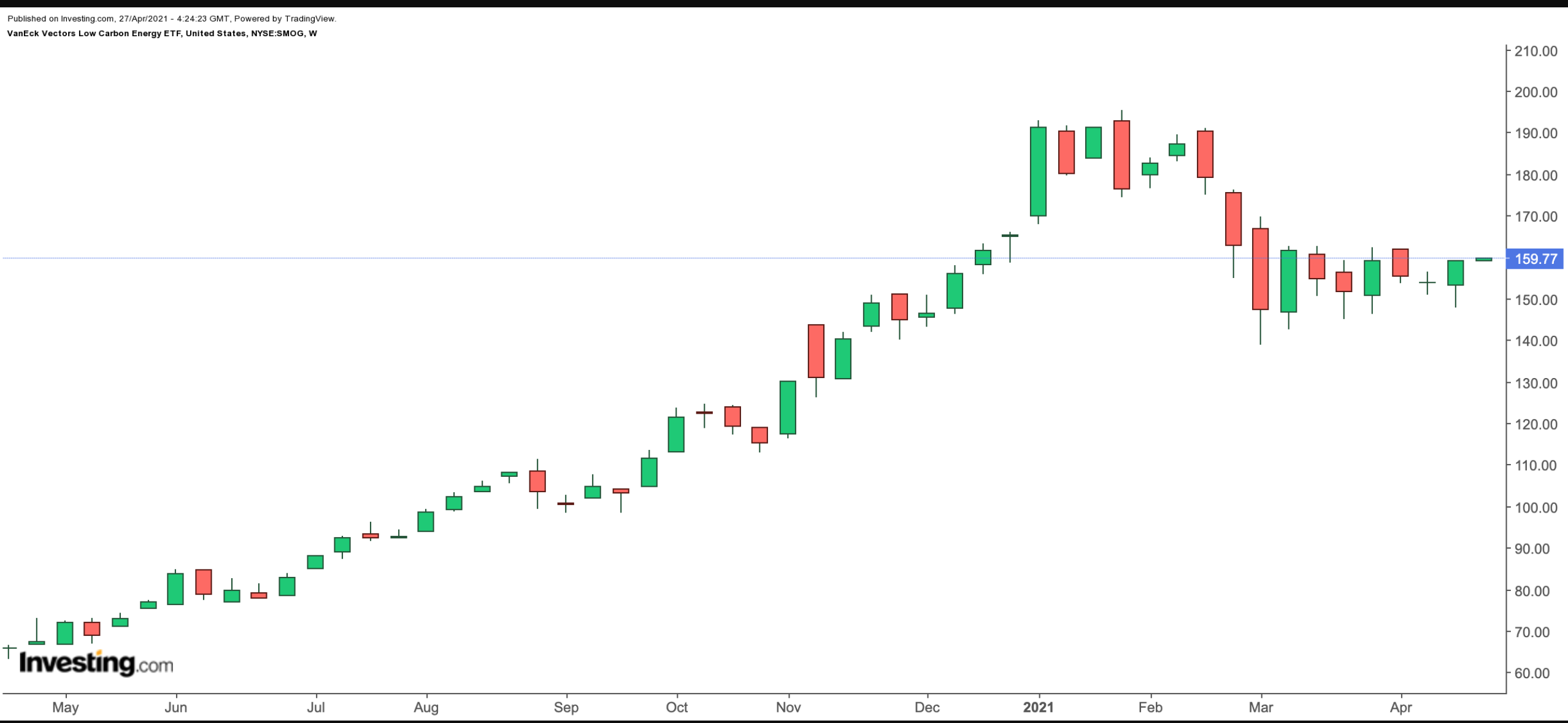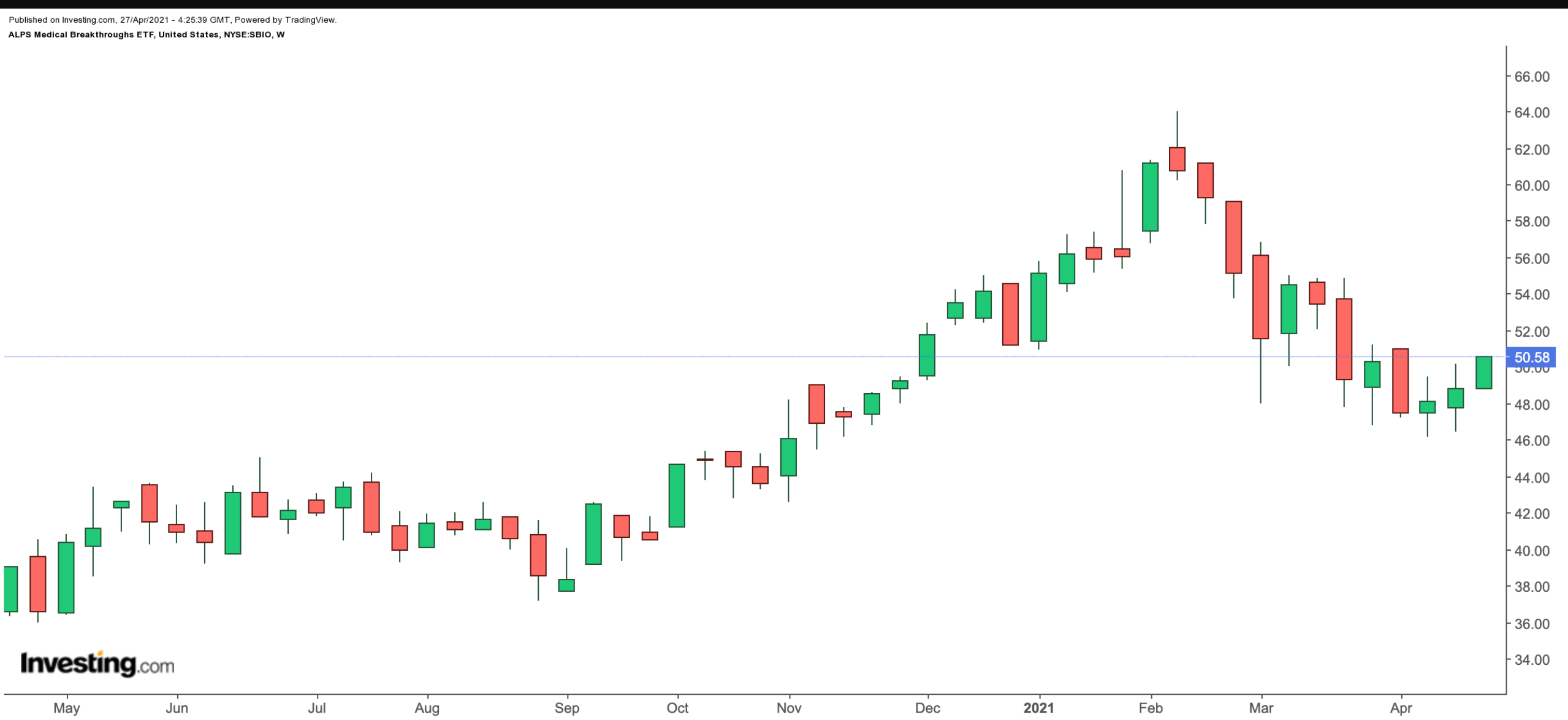Broader markets are close to record highs. Year-to-date, the Dow Jones Industrial Average, the S&P 500 and the NASDAQ 100 are up around 11.5%, 11.6% and 8.2%, respectively.
However, not all sectors have shown a solid performance so far this year. We recently covered exchange-traded fund (ETF) winners and losers in the first quarter. Today, we discuss two funds that have come under pressure in the last weeks. Their fortunes might fare better in the rest of the quarter.
1. VanEck Vectors Low Carbon Energy ETF
Current Price: $159.77
52-Week Range: $65.06 - $195.55
Dividend Yield: 0.06%
Expense Ratio: 0.62% per year
Last year was a momentous time for shares of electric vehicles and alternative-energy businesses. As consumer interest in green energy increased, investors put their faith in these stocks, too. For the Biden administration, clean energy also has become a top priority.
One of the funds that did well was the VanEck Vectors Low Carbon Energy ETF (NYSE:SMOG). In the past 52 weeks, it returned 141% and hit a record-high on Jan. 25. However, since then, profit-taking has kicked in, and it has lost about 20% of its value. Year-to-date, the fund is down almost 4%.

The fund is a play on the low-carbon theme. It invests in firms that focus on alternative energy, including biofuels (for example, ethanol), wind, solar, hydro and geothermal sources. It also buys shares of firms that focus on EVs, lithium-ion batteries, waste-to-energy production, as well as smart grid technologies.
SMOG has 65 holdings and tracks the MVIS Global Low Carbon Energy Index returns, which is rebalanced quarterly. Since its inception in May 2007, the fund has reached $427 million in net assets.
In terms of sectors, information technology has the highest weighting with 35.5%. Next in line are industrials (27.7%), consumer discretionary (20.0) and utilities (9.3%). The top 10 names make up almost 64% of the fund. Among the leading names are power management group Eaton (NYSE:ETN), EV darlings Tesla (NASDAQ:TSLA) and Nio (NYSE:NIO), Danish wind power group Vestas Wind Systems (OTC:VWDRY) and semiconductor firm Microchip Technology (NASDAQ:MCHP).
Given the recent decline in the price of SMOG, we feel the fund now offers a better risk-return profile for buy-and-hold investors. Any further slide toward the $150 level would make the fund even more attractive. However, we should remind our readers that the combined weighting of Tesla and Nio is almost 20% in this top-heavy fund. Therefore, moves in the prices of these stocks will affect the ETF.
2. ALPS Medical Breakthroughs ETF
Current Price: $50.58
52-Week Range: $36.00 - $64.04
Dividend Yield: N/A
Expense Ratio: 0.50% per year
The ALPS Medical Breakthroughs ETF (NYSE:SBIO) focuses on small- and mid-capitalization biotechnology and pharmaceutical firms. The market cap range is between $200 million and $5 billion. In addition, these firms would have one or more drugs in either Phase II or Phase III of the U.S. Food and Drug (FDA) Administration clinical trials.

According to the FDA, clinical research studies "are done in people. Clinical trials follow a typical series from early, small-scale Phase 1 studies to late-stage, large scale Phase 3 studies."
SBIO, which has 104 holdings, tracks the returns of the S-Network® Medical Breakthroughs Index. The fund started trading in December 2014. The top 10 stocks comprise more than 30% of net assets of $246 million.
Fate Therapeutics (NASDAQ:FATE), which specializes in cellular immunotherapies for cancer and immune disorders; Vir Biotechnology (NASDAQ:VIR), which focuses in infectious diseases; Emergent Biosolutions (NYSE:EBS), which aims to develop medical countermeasures against emerging public health threats; Arena Pharmaceuticals (NASDAQ:ARNA), which is working on developing small molecule drugs; and Legend Biotech (NASDAQ:LEGN), which works on cell therapies for oncology; lead the names in the roster.
In the past 12 months, the ETF is up 27.5% and hit an all-time high in early February. However, since then the fund has lost more than 21% of its value. Given the niche focus of the fund, SBIO might appeal to investors who are able to allocate capital to high risk/high return biotechnology.
